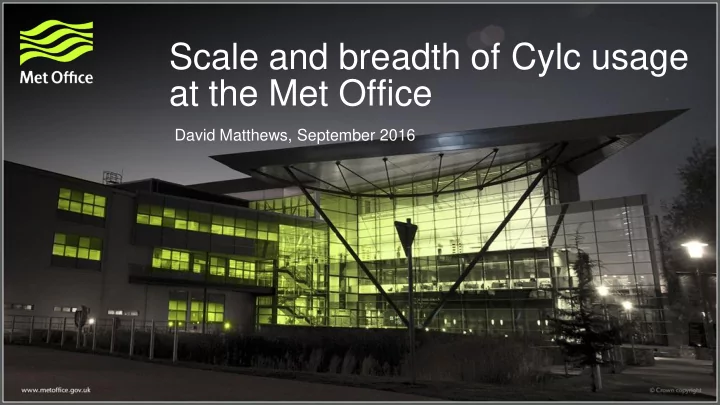

Scale and breadth of Cylc usage at the Met Office David Matthews, September 2016
Overview of Cylc usage at the Met Office Where ? (platforms) Who ? (number of uses) Why ? (types of usage)
Some history Nov 2011 - Chose Cylc Nov 2012 - System ready for general use Jan 2014 - Main operational implementation
Where do we install Cylc (& Rose)? Research system Main operational system (controls operational work on our HPC) Standalone production systems External systems • Monsoon (Met Office and NERC joint supercomputer system) • JASMIN (super-data-cluster for the UK environmental science community) • ECMWF
Managing multiple versions of Rose/Cylc We maintain multiple versions of Rose & Cylc in parallel • default version (most suites use this) • "next" version: typically the latest release • a number of key users / suite owners help test this • not all releases become default versions • length of testing period partly determined by how many significant changes there are in a particular release • operational version (used by our operational system) • old versions retained until no longer in use Rose/Cylc setup ensures running suites continue running with same version of Rose & Cylc when we change the default version Suites can be configured to use particular versions if required
Metomi VMs Virtual machines with Rose & Cylc installed & configured Useful for training & demo purposes - e.g. this workshop! Testing portability Several systems now using these VMs as a development platforms for remote users / developers e.g. UM, JULES https://github.com/metomi/metomi-vms
Operational suites (everything that is “operational” on our HPC) Suites run on a Virtual Machine (VM) with 8GB RAM, 4 CPU 3 VMs in total (live + parallel + test) Suites + GUIs + Rose Bush all run on same server (not ideal) ~28 suites ~18,000 tasks per day
Operational suite monitoring cylc gscan is a valuable tool for our operators
Research system setup Users submit suites and run GUIs on Linux desktops (600+) Suites run on 10 dedicated VMs • least loaded server chosen for each suite submitted Suites control tasks running on several different HPC & Linux clusters Separate web server provides access to suite log files via Rose Bush • Cylc automatically copies back log files from remote systems for viewing
Dedicated cylc VMs Why? • more resilience • no need to switch off or reboot (unlike desktops) Low specification: 8GB RAM, 2 CPU Capacity • 10 servers currently • have had up to 100 suites running on a single server
Why is efficiency so important? Larger, more complex suites, for example • 4D-ensemble-Var scheme of order 100-200 members • Climate ensemble with 400 members x 6 tasks x 300 cycles More users running more suites Optimising Cylc to reduce resource requirements helps us to minimise the number of servers required
Global NWP suite graph 3 cycles ~700 tasks per cycle (Some families grouped)
Cylc memory usage Example using our global NWP suite
Cylc usage on our Research system
Suite version control usage We provide a system for Suite Storage and Discovery as part of Rose. Subversion is used for version control We have a system for internal use + an external system for collaboration Commits per month external: ~1900 internal: ~1700 Number of committers in last year external: 430 internal: 380
What are all these suites? Initial focus was on NWP modelling and then climate modelling (to replace legacy systems) Increasingly used for wide variety of purposes (post processing, etc) Drivers: Due to increased complexity, increased data volumes, drive for greater efficiency, etc there is 1. More work that needs to be run via a workload manager (e.g. Slurm, PBS) 2. More work that needs to use task parallelism to complete in a reasonable time Just running on a desktop just isn't an option any more! Cylc provides us with a general purpose workflow solution to meet this need - still lots of potential areas for growth
Automated functional & regression testing A less obvious benefit of our use of cylc "Rose Stem" - a special type of cylc suite • Suite is stored with the source code • Custom interface makes it easy for developers to define which tests they want to run • Utility provided for analysing outputs By standardising the approach (and making it easier) we now have • Many more systems taking advantage of automated testing • Much improved test coverage (more tests per system) • Portable test suites which can run at multiple sites, helping us work across the UM partnership
Summary We have invested heavily in our Rose/Cylc infrastructure We are reaping significant benefits from this investment ... but it takes time! Still lots of work to do and lots more benefit to come
Thank you for listening, any questions?
Recommend
More recommend